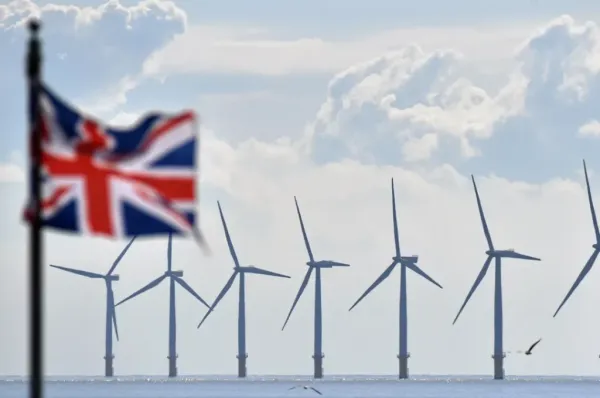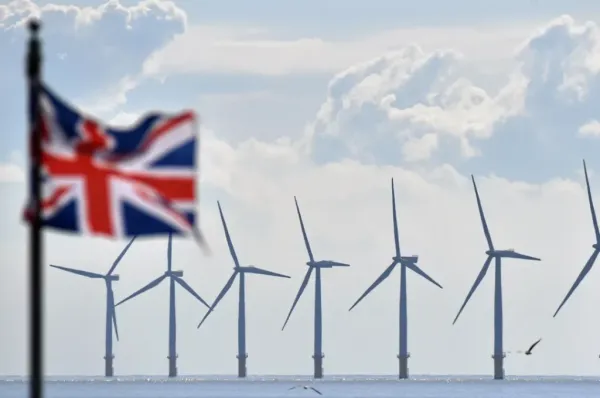

In 2024, the United Kingdom achieved a significant milestone in renewable energy generation, setting a record for wind power production. According to the latest data from the National Energy System Operator (Neso), wind power generated nearly 83 terawatt-hours (TWh) of electricity across Great Britain—encompassing England, Wales, and Scotland. This marked an increase from the 79 TWh generated in 2023, showcasing a growing reliance on wind as a major energy source. The surge in wind energy output reflects the UK’s ongoing efforts to reduce its dependence on fossil fuels and transition toward cleaner, more sustainable energy sources.
Electricity generation from major fossil fuel power stations has significantly declined, dropping to just over a quarter of the total energy output in 2024. This decline comes as other renewable sources, including solar energy, saw an uptick in their contributions, alongside a steady rise in electricity imports. The shift away from fossil fuels is in line with the government’s ambitious goal to have less than 5% of electricity generated from polluting fossil fuels by 2030. The government’s ‘Clean Power 2030 Action Plan’ is viewed as challenging but achievable, according to Neso, which has emphasized that the plan is at the limits of feasibility.
Renewable energy, including wind, solar, hydropower, and bioenergy, as well as nuclear power, generated around 56% of the UK’s electricity in 2024, marking a new record high. Preliminary data from Neso, which will be confirmed later this week, indicates this is a significant increase from previous years. Major fossil fuel generation, predominantly from gas, accounted for only 26% of the total electricity generation, while 16% of the electricity came from imports.
This shift in energy generation has been part of the UK’s broader energy transition since 2014 when wind and solar energy together accounted for about 10% of the nation’s electricity. Today, these renewable sources now contribute nearly a third of the total electricity. Over the same period, fossil fuel generation has decreased by more than half, largely due to the decline in coal usage—the dirtiest of fossil fuels. The closure of the UK’s final coal power station in 2024 marked a symbolic end to the country’s coal reliance. Gas generation, however, remains an essential component of the UK’s energy mix, as it helps provide a reliable backup when weather-dependent renewable sources like wind and solar are not producing enough electricity.
The move away from fossil fuels has contributed to a significant reduction in carbon emissions from electricity generation. In 2024, each kilowatt-hour (kWh) of electricity generated produced just 124 grams of carbon dioxide on average, marking a new low. This is a substantial improvement from 2014 when the carbon intensity was 419 grams per kWh. However, gas power remains a key part of the energy landscape, especially in times when wind and solar energy production falls short.
Britain’s wind turbines have shown their potential to generate massive amounts of electricity when weather conditions are favorable. For instance, during December 2024, there were about 10 days when more than 50% of the country’s electricity came from wind power. However, wind energy is not constant, and there are periods when wind generation drops, creating a need for backup power sources. In such instances, gas power stations are crucial, as they can be quickly activated to fill the gaps. Between December 11 and 13, 2024, for example, gas generation accounted for over 60% of the electricity production due to a drop in wind power.
In response to these challenges, the government has been exploring solutions such as energy storage technologies, including batteries, which could store surplus wind energy during windy periods and release it when generation falls. Additionally, there may be incentives for consumers to use electricity during high-wind periods by offering cheaper prices, helping to balance supply and demand.
The UK government’s plan to meet its 2030 clean energy target involves maintaining a reserve capacity of gas power stations, ensuring that there is a reliable backup during periods of low wind or solar generation. Despite the challenges of maintaining a stable energy supply, the government remains committed to its clean energy objectives.
However, the transition to a low-carbon energy system has sparked debate. Claire Coutinho, the Conservative shadow secretary of state for energy security, recently criticized the Labour Party’s push for rapid decarbonization, arguing that it could lead to higher electricity prices and increased hardship for consumers across Britain. Coutinho emphasized the need for affordable and reliable energy, stating that pushing for a quicker transition could result in higher bills for households.
The UK continues to make strides in its energy transition, the record-breaking year for wind power in 2024 stands as a testament to the country’s progress toward a cleaner, more sustainable future. However, the need for a balanced and reliable energy mix, incorporating both renewables and backup power sources like gas, remains critical to ensuring the stability of the national grid and meeting the energy needs of its population.
The post appeared first on .